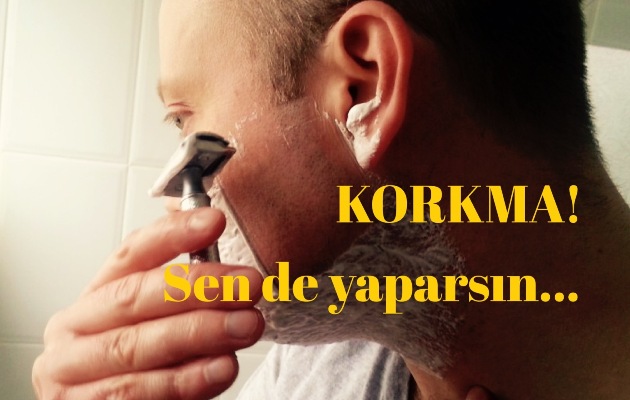Safety Razor Shave
22 September 2018
If you have come this far and found this article, then you are already half the way. Now you might need a little more insight to understand the mechanics and logic of the topic. So read on:
Right, until now you’ve used multi-blade systems. In the shaving literature we call them “cartridge razors”. The cartridges are characterized by the fact that the blades (or the strips) are enclosed in a plastic case and they can only come into contact in a limited manner with the skin from the enclosure. This way security is ensured, you can quickly shave without the need for any hand dexterity. But in safety razors, the cutting edge of the blade is not limited with a plastic case to contact your skin; it has a direct contact. But this contact is only possible at a certain shaving angle, which is approx 25 to 35 degrees. So, you need to keep this angle to have the blade touch on your skin.
Let’s explain it in detail; since most cartridge razors have pivoting heads, the user doesn’t have to think about the angle. You take the razor, press it on your skin and pull it down to shave. When pressed, the head rests parallel on your skin; pivots if needed and since the blades are already fixed at 30 degrees, the shaving angle is adjusted automatically. But with safety razors, there's no such thing as “pivoting head". You have to adjust the right angle by yourself, and get used to maintaining that angle as you shave different parts of your face. But, don’t worry, this is not a big deal. It takes only about 1 to 10 shaves to get used to.
Once you get used to keeping your safety razor at the right angle and enjoy its delightful shave; it’s almost impossible to return back to a cartridge razor anymore. You will notice that, not only 5-blade, even a 15-bladed cartridge razor cannot provide the close and effortless shave of a direct cutting safety razor; nor provide such shaving pleasure of a close, manly shave. The cutting mechanics of the cartridge razor (as you will remember from the commercials), is the first blade to cut the whisker, while pulling it a little for the following blade and the next blade cuts a part of that stretched whisker; following the next one cutting even more. This keeps going progressively. Here, we usually come across with two types of problems:
 1. Since each whisker doesn’t grow evenly each day, some of them happen to be shorter and not even the first blade cannot catch them. So, this whisker can not be cut. It may be hardly noticeable immediately after the shave, but after a few hours, a gray face called “5 o’clock shadow” will welcome you as those shorter whiskers start to show themselves. This is why you generally get better shaves from a few days of growth since there are no short whiskers and every one of them get caught by the first blade easily.
1. Since each whisker doesn’t grow evenly each day, some of them happen to be shorter and not even the first blade cannot catch them. So, this whisker can not be cut. It may be hardly noticeable immediately after the shave, but after a few hours, a gray face called “5 o’clock shadow” will welcome you as those shorter whiskers start to show themselves. This is why you generally get better shaves from a few days of growth since there are no short whiskers and every one of them get caught by the first blade easily.
2. Let's take a look at the whiskers that get caught by the first blade. You’ll recall the animation on the right: The first blade cuts the whisker and pulls it out while cutting. Then the next blade catches it, cuts it, and then extends it slightly more. The next blade is doing the same thing again and this keeps going. After all the blades passed, that whisker retracts to its natural position. At this point, we observe the final part of the whisker cut is actually below the skin surface. When it retracts and the skin closes on it, this whisker may not emerge to skin surface in some sensitive skins, starting to grow inside. So, this overly cut whisker becomes an ingrown hair, causing pain and inflammation even infection.
Now let's get to the safety razors. First, why is it called "safety" razor? Because the razor’s blade opening is limited with a safety bar for safety and ease of shave. If you keep the razor at right angle the blade will be in contact with your skin, but with a fixed depth and will not go too deep thanks to that safety bar. If you can not keep the right angle, the blade will not even touch the skin. So, maintaining that right angle falls to you.
So, what’s the trick?:

The first time with a safety razor, you may not be able to find the correct angle right away since you are not familiar with it. So you may feel as the razor does not cut your beard clean. Then your first reflex will be pushing the razor more to the skin as you usually do with cartridge razors. But pushing the safety razor to the skin does not end up with a cleaner shave for the areas where you fail to find the correct angle. It only causes irritation on the areas where the angle is correct.
So what you need to focus is only the angle. When you find it, there is absolutely no need to push the razor. Its own weight is enough, simply maneuver the razor and it will do the job by itself. So, during the first few shaves just be aware of this fact, do not press the razor on your face and just focus on your angle and be aware of your pushing tendancy.
Lets re-phrase it like that: If you can’t get a clean cut, just stop for a while, think and change your angle a bit. That's all. When you keep this in your mind, you’ll get very pleasurable shaves in no time.
Just stop for a while; breathe and change your angle…

Attention Please!:
There are some safety razors classified as "aggressive" in our web-store, that we don't recommend to beginners. We call them “aggressive” because those razors have bigger gaps between the blade edge and the safety bar. This results a much more direct and deeper contact to the skin, on the safety bar design of the head. If you have not developed the hand-habit of effortless shaving with correct angle, these kind of razors may cause irritations, nicks, cuts and razor burns, which may end your traditional shaving journey. That's why we don't recommend them to beginners.
So what about adjustable razors? Why don’t we recommend them to beginners?
Same reason. If you’re a beginner you won’t be able to find your angle at your first shaves. When you crank up the razor and see it’s easier to find the angle on an aggressive setting, you’ll be tempted to use those aggressive settings. Then same things will happen as explained above. You’ll get tons of irritations, dishearten, and your pleasurable traditional shaving journey will end right at the beginning. So, it’s best to start with a moderately milder razor.
Note: Traditional wet shaving is generally done in 2 or 3 passes. Don’t try to cut all your whiskers in one pass like you do with cartridge razors. The logic behind multiple passes is to cut the whiskers gradually without wearing the skin. Don’t pass over the same area again and again this will only cause irritation and razor burn, but not a close shave. If you see a spot not shaven well, leave it there, you’ll get it in the next pass. Repainting your face with a fragrant, hot lather is one of the most enjoyable parts of the ritual; so, don’t rush it; enjoy it!
Note 2: Always shave in the direction that your whiskers grow in the first pass. In other words: “with the grain” (WTG). In your second pass, you can either shave again with the grain or across the grain (XTG) for a closer result. Across the grain shave can be done from the nose to ear or from ear to the nose. Two passes are generally enough for most of us on daily basis. But if you need a real close "BBS" shave, you may go up to 4 passes depending the razor & blade combination you use and your beard density. But 3 and 4 pass shaves are not suitable for everyday shaves, as your skin will wear down soon and your skin may become dry and flaky no matter what aftershave you use. But there is no certainty in wet shaving since it’s a subjective topic and everybody’s skin and beard is different. At any rate, we recommend 4 pass shaves only for special occasions where you need a super close shave.
May your shaving pleasure ever lasts !